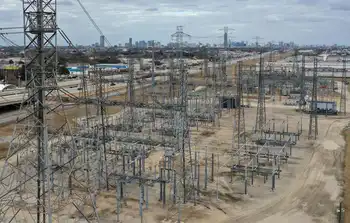Power producers meet record Texas demand
TEXAS - Triple-digit heat in parts of the state led Texans to use a record amount of power August 17, with consumers drawing an average of 63,056 megawatts of electricity between 4 p.m. and 5 p.m.
That toppled the previous record of 62,396 megawatts set July 17 and exceeds the 2005 peak by 4.6 percent, according to the Electric Reliability Council of Texas, the organization that oversees the power grid for most of Texas.
Early in the afternoon of August 17, ERCOT anticipated the record and asked residents and businesses to scale back use of air conditioners and other appliances.
ERCOT officials said they did not need to take emergency actions, such as initiating rolling blackouts, and that supply kept pace with the state's needs.
Four months ago, on the afternoon of April 17, ERCOT asked power providers to start rolling blackouts throughout the state to keep sections of the system from crashing. Unseasonably high temperatures hit on a day when about 20 percent of the state's power plants were down for previously scheduled maintenance, leading demand to exceed supply.
"Although the temperatures this week have been hotter than the April heat wave, our situation today is drastically different," ERCOT chief Sam Jones said recently. "In August, we expect high temperatures and expect to break records in a growing state like ours, so we are prepared."
TXU, Texas' largest power plant operator, used the high demand as an opportunity to bolster its plans to build 11 coal- fired plants in Texas in the next few years.
The plans have been put on fast track for environmental review by Gov. Rick Perry, a move some environmental groups and city governments have opposed.
TXU used the specter of California's power generating problems to dismiss critics.
"We've all seen California's continuing reliability problems, and we don't want Texas to experience the same problems here," TXU Chairman John Wilder said in a prepared statement.
Kent Saathoff, director of system operations for ERCOT, said power demand this summer has actually started to flatten out about an hour earlier than in past summers, helping to avoid crisis situations.
The flattening may be a result of programs power providers have with their largest industrial customers that encourages them to cut back at times of peak demand, typically between 3 p.m. and 5 p.m.
Recycling coal for a runway: Fly ash from power plants used for paving Aug 18, 2006 - Milwaukee Journal Sentinel A $3 million project at Crites Field is saving the Waukesha County airport $50,000 thanks to a byproduct of the coal- burning process in power plants in Pleasant Prairie and Oak Creek. Fly ash from We Energies coal-fired power plants is being used this week to rebuild an auxiliary runway and roadways at the airport.
Once upon a time sent to landfills, fly ash is now recycled for use in pavement projects. Waukesha's is the first airport in southeastern Wisconsin to use the coal-burning byproduct, We Energies said.
The fly ash is marketed as a replacement for Portland cement, the type of cement used in virtually all concrete.
When coal is pulverized down to a powder and then combusted in the power plant boiler, the fly ash is captured before it can escape through a plant smokestack. Fly ash, which represents about 5% of the coal that comes into the power plant, works as a lubricant, binding recycled pieces of pulverized asphalt from the old runway together, said Bruce Ramme, manager of land quality at We Energies.
"Airports are probably one of the most challenging applications as far as the performance of pavement, so we're honored to see our fly ash being used in this airport," Ramme said.
We Energies sells its fly ash to Lafarge North America, which transports and delivers the fly ash from the utility's coal plants to various construction sites. This year, the biggest project for We Energies and Lafarge has been at Chicago's O'Hare International Airport, where fly ash is being used for soil stabilization, he said.
Jim Rosenmerkel, an engineer who does consulting work for Lafarge, said fly ash from Wisconsin coal plants has been used at airports in Antigo and Merrill. The Waukesha project ended up saving $50,000 off a price tag of nearly $200,000 that would have been needed to use a more conventional pavement approach.
"It saved the taxpayers here about 25 percent" on the pavement- related portion of the Waukesha airport project, he said. "That's pretty big."
Demand has been so high for the product that We Energies is using more fly ash than its power plants produce. The utility has started to scoop old fly ash from landfills where it was disposed years ago, Ramme said.
The utility told regulators its sales of fly ash totaled $3.15 million last year.
The key for the utility comes in the savings on landfill costs and the ability to make use again of coal, already used once in the electric power generation process.
"You're essentially turning it back into a rock again," Ramme said.
Related News

Electric Cooperatives, The Lone Shining Utility Star Of The Texas 2021 Winter Storm
HOUSTON - Winter Storm Uri began to hit parts of Texas on February 13, 2021 and its onslaught left close to 4.5 million Texas homes and businesses without power at its peak. By some accounts, the preliminary number of deaths attributed to the storm is nearly 200, and the economic toll for the Lone Star State is estimated to be as high as $295 billion.
The more than two-thirds of Texans who lost power during this devastating storm were notably more negative than positive in their evaluation of the performance of their local electric utility, with one exception. That exception are…




